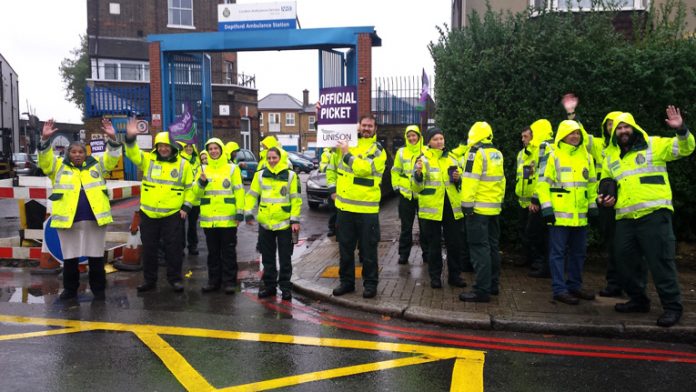
A SHORTAGE of ambulances and paramedics along with a ‘meltdown’ of A&E services has lead to an extremely alarming spike in patient deaths, as patients are not getting to hospital in time and instead are dying in the back of the ambulance.
The number of cases of ‘Dead On Arrival’ (DOA) has more than doubled in four years.
The number of cases of ‘Dead On Arrival’ (DOA) has more than doubled in four years.
Serious incidents resulting in the death of a patient rose from 31 in 2012 to 72 in 2016.
NHS figures for England obtained under the Freedom of Information Act (FoI) show the deadly effect of Tory cuts.
One trust noted that a serious incident meant a three-year-old asthma patient had died, and another death was logged as being caused by a delayed response linked to ‘no resources’.
Serious incidents are logged when the consequences for patients and staff are so significant they warrant investigation.
The number of such reports rose sharply over the five-year period, almost doubling from 194 in 2012 to 376 last year.
Labour shadow health secretary Jonathan Ashworth said: ‘Despite the heroic efforts of our hardworking paramedics, ambulance targets have been missed for well over two years and unprecedented pressures on ambulance services are placing patient safety at serious risk.’
Alan Lofthouse, the national ambulance officer at the trade union Unison, said: ‘The government’s own figures show that ambulance demand is running at twice the level of funding.
‘This is an unsustainable situation that places excessive pressure on paramedics, who are doing an incredible job treating people in the community and reducing the strain on A&E departments.’
One death, in May 2017, was because an ambulance was diverted from one hospital to another at the last minute.
Ambulance diverts are often because the A&Es are so full that it is quicker to divert to another A&E rather than wait in a queue of ambulances.
‘Up and down the country our A&E departments are in meltdown, our staff are at breaking point and we need your help,’ Rob Galloway, an A&E consultant from Brighton wrote in an open letter yesterday.
‘Patients are being left in corridors because there are no ward beds for them to go to, staff are leaving shifts demoralised and exhausted and most importantly our patients are not getting the care they deserve.
‘We need the public to know about this, not to scaremonger, but for the truth to be out there – as the only way to get politicians to change – is by voters knowing the reality and prioritising the NHS at the ballot box.’
He also said hospitals should say how many people spend time waiting in corridors before they are admitted to wards.
He added: ‘The fault does not lie with the patients. Yes a few inappropriately attend – but they are not the problem; they can be quickly turned around and discharged.
‘The fault is not with the staff. They are working tirelessly and doing an amazing job despite the conditions they are working in. Despite what the government peddle it certainly is not the fault of the GPs.
‘Although there is falling numbers of GP surgeries, they are doing an amazing job at reducing the number of A&E attendances.
‘And the fault does not lie with the “system” of the NHS – a model of care which utilitises its resources to maximal effect.
‘The fault lies with the government. Years of failed austerity depriving NHS and councils of vital monies and investment is taking its toll. A&Es are struggling because of the frail elderly who need a ward bed, but can’t get one.
‘They can’t get one because there are not enough beds within our hospitals.’